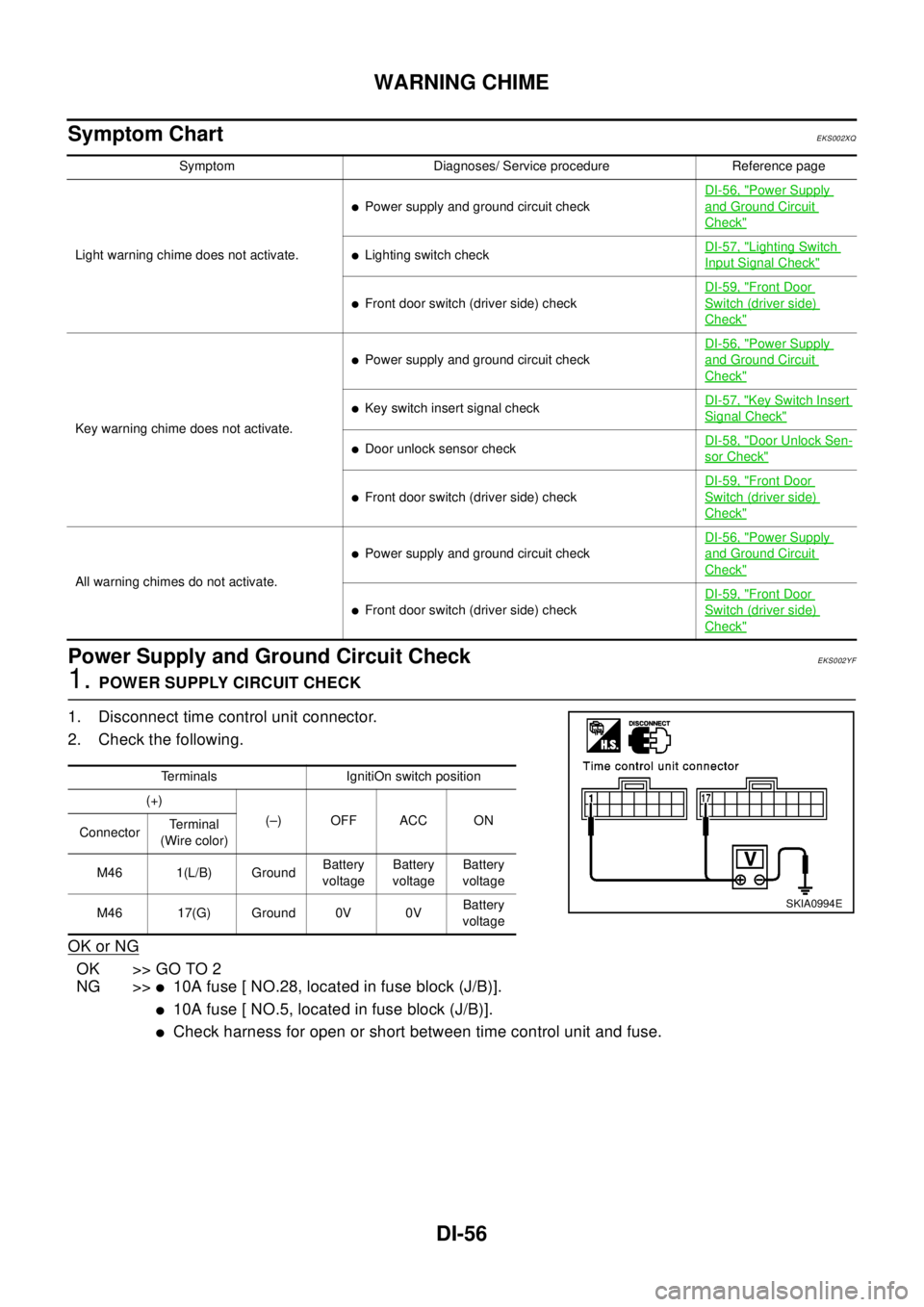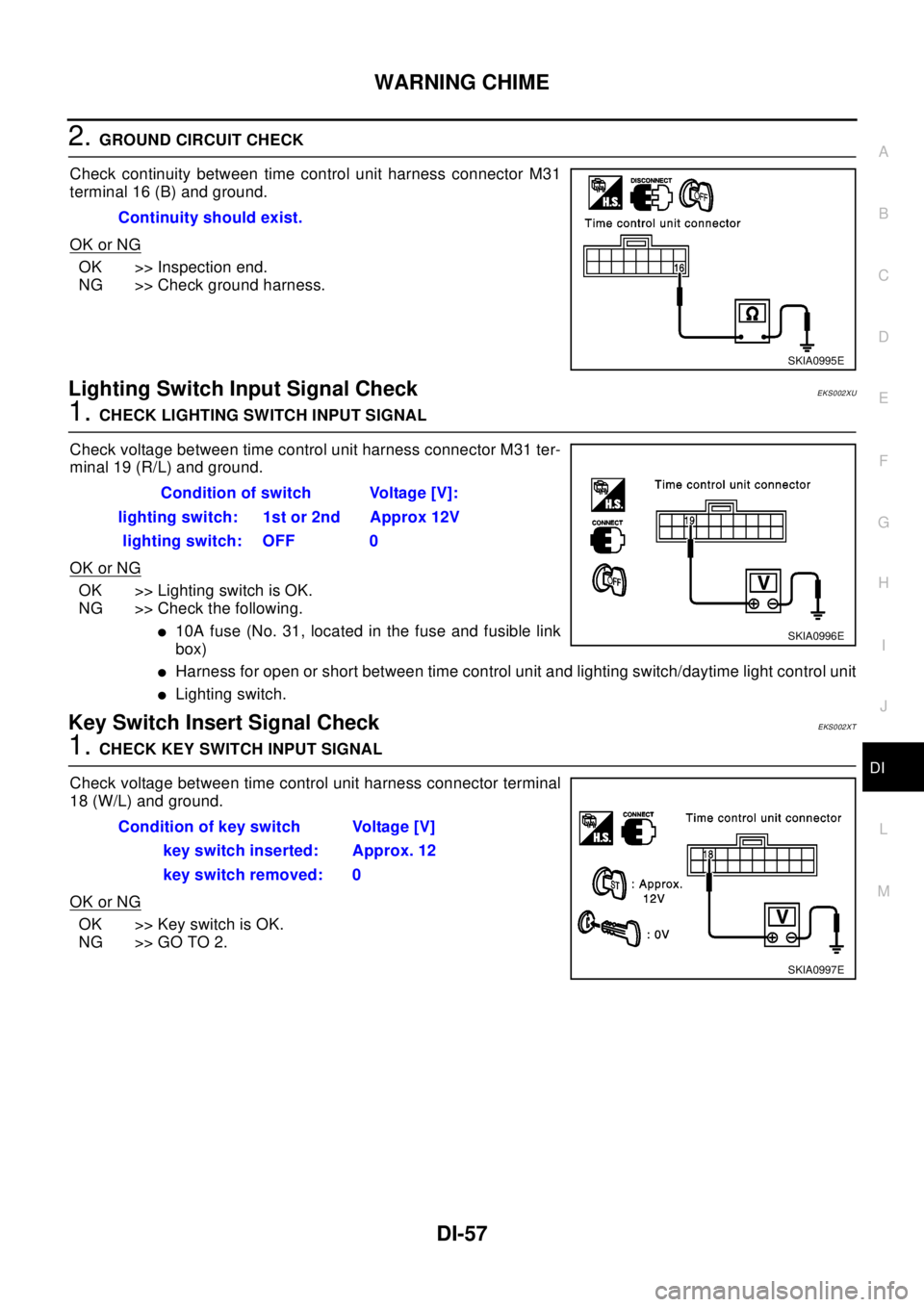2003 NISSAN X-TRAIL warning light
[x] Cancel search: warning lightPage 925 of 3066
![NISSAN X-TRAIL 2003 Electronic Repair Manual GENERAL INFORMATION
BRC-57
[ESP/TCS/ABS]
C
D
E
G
H
I
J
K
L
MA
B
BRC
lWhen starting the engine, or just after starting the vehicle, the brake pedal may vibrate or the
motor operating noise may be heard NISSAN X-TRAIL 2003 Electronic Repair Manual GENERAL INFORMATION
BRC-57
[ESP/TCS/ABS]
C
D
E
G
H
I
J
K
L
MA
B
BRC
lWhen starting the engine, or just after starting the vehicle, the brake pedal may vibrate or the
motor operating noise may be heard](/manual-img/5/57402/w960_57402-924.png)
GENERAL INFORMATION
BRC-57
[ESP/TCS/ABS]
C
D
E
G
H
I
J
K
L
MA
B
BRC
lWhen starting the engine, or just after starting the vehicle, the brake pedal may vibrate or the
motor operating noise may be heard from the engine compartment. This is a normal status of the
operation check.
lThe stopping distance may be longer than that of vehicles without ABS when the vehicle drives on
rough, gravel, or snowy (fresh deep snow) road.
TCS FunctionsEFS0019V
1. With the wheel speed sensor signals from 4 wheels, the ESP/TCS/ABS control unit detects a wheel spin.
If a wheel spins, the control unit controls brake fluid pressure to the spinning wheel, and cuts the fuel to
the engine. It also closes the throttle valve to reduce the engine torque. Furthermore, throttle position is
controlled to the appropriate engine torque.
2. If a wheel spins, the TCS system works same as LSD (Limited Slip Differential) function applying brake
fluid pressure to the spinning wheel.
3. During TCS operation, it informs a driver of system operation by flashing SLIP indicator lamp.
CAUTION:
lDuring TCS operation, the body and the brake pedal lightly vibrate and the mechanical noise may
be heard. This is a normal condition.
lDepending on road circumstances, the driver may have a sluggish feel. This is not abnormal,
because the optimum traction has the highest priority by TCS operation.
lWhen the vehicle is passing through a road where the surface friction coefficient varies, down-
shifting or depressing the accelerator pedal fully may activate TCS temporarily.
ESP FunctionsEFS0019W
1. The Electronic Stability Program is called the ESP for short.
The ESP is indicated as the VDC (the Vehicle Dynamics Control) on the CONSULT-II screen.
2. In addition to the ABS/TCS function, ESP detects the driver's steering operation amount and brake opera-
tion amount from the steering angle sensor and pressure sensor. Using the information from the yaw rate/
side G sensor and wheel speed sensors, ESP judges the driving condition (conditions of understeer and
oversteer) to improve the stability by controlling the brake on 4 wheels and engine output.
3. During ESP operation, the SLIP indicator lamp flashes to inform the driver of the operation.
CAUTION:
lDuring ESP operation, the body and the brake pedal lightly vibrate and their mechanical noise
may be heard. This is a normal condition.
lIf the vehicle is rotated on a turn table, or rolled and rocked on a ship, the ABS warning lamp,
ESP OFF indicator lamp, and SLIP indicator lamp may turn ON. In this case, start the engine on a
normal road again. If the ABS warning lamp, ESP OFF indicator lamp, and SLIP indicator lamp
turn OFF after the restart, it is normal.
lWhen driving in a steep slope such as a bank, the ABS warning lamp, ESP OFF indicator lamp,
and SLIP indicator lamp may turn ON. In this case, start the engine on a normal road again. If the
ABS warning lamp, ESP OFF indicator lamp, and SLIP indicator lamp turn OFF after the restart, it
is normal.
Page 956 of 3066
![NISSAN X-TRAIL 2003 Electronic Repair Manual BRC-88
[ESP/TCS/ABS]
TROUBLE DIAGNOSIS
For Correct and Quick Diagnosis
EFS001A8
PRECAUTIONS FOR TROUBLE DIAGNOSIS
lBefore performing the trouble diagnosis, always read theGI-3, "PRECAUTIONS"to confirm NISSAN X-TRAIL 2003 Electronic Repair Manual BRC-88
[ESP/TCS/ABS]
TROUBLE DIAGNOSIS
For Correct and Quick Diagnosis
EFS001A8
PRECAUTIONS FOR TROUBLE DIAGNOSIS
lBefore performing the trouble diagnosis, always read theGI-3, "PRECAUTIONS"to confirm](/manual-img/5/57402/w960_57402-955.png)
BRC-88
[ESP/TCS/ABS]
TROUBLE DIAGNOSIS
For Correct and Quick Diagnosis
EFS001A8
PRECAUTIONS FOR TROUBLE DIAGNOSIS
lBefore performing the trouble diagnosis, always read theGI-3, "PRECAUTIONS"to confirm the general
precautions.
lAfter replacement of ESP/TCS/ABS control unit, steering angle sensor, steering parts, suspension parts,
or tires, and adjustment of alignment, always adjust the neutral position of steering angle sensor before
driving.
lWhen the ESP/TCS/ABS control unit is replaced, check that the label on the computer unit is identical
color.
lAfter completing the trouble diagnosis, always erase the malfunctioning memory.BRC-77, "Functions of
CONSULT-II"
lWhen inspection of the continuity or voltage between units is performed, check the connector terminals for
disconnection, looseness, bend, or collapse. If any malfunction is detected, repair or replace the applica-
ble part.
lIntermittent problems may be caused by a malfunction on harness, connector, or terminal. Move the har-
nesses, harness connectors, or terminals by hand to make sure that there is no contact malfunction.
lIf a circuit tester is used for the check, be careful not to forcibly extend any connector terminal.
lFor self-diagnosis, active test, and work support of ESP/TCS/ABS control unit with CONSULT-II, stop and
connect CONSULT-II and select²ABS².
lCONSULT-II self-diagnosis results are displayed without regard to occurrence timing. In some case, the
later ones (timing value is small) appear on the next screen.
lWhile the self-diagnosis results of CONSULT-II shows a malfunction, if CONSULT-II active test is per-
formed, an engine system malfunction may be indicated. In this case, start the engine to resume the nor-
mal screen.
lESP/TCS/ABS system electronically controls the brake operation and engine output. The following symp-
toms may be caused by the normal operations.
Symptom Symptom description Result
Motor operation noiseDuring ESP, TCS, or ABS operation, sometimes a faint noise can be
heard. This is a motor operation noise in the ESP/TCS/ABS actuator.
Normal
Just after the engine starts, the motor operating noise may be heard.
This is a normal status of the system operation check.
System operation check
noiseWhen the engine starts, a²click²noise may be heard from the engine
compartment. This is a normal status of the system operation check.Normal
ESP/TCS operation
(SLIP lamp ON)When the vehicle is passing through a road where the surface friction
coefficient varies or the wheel speed changes suddenly by downshifting
or depressing of the accelerator pedal fully, TCS may be activated tem-
porarily.
Normal
Cancel the ESP/TCS
function for the
inspection on a chas-
sis dynamometer. Before the speedometer inspection, turn ESP OFF switch off to cancel
the ESP/TCS function.
When the accelerator pedal is depressed on a chassis dynamometer,
the vehicle speed will not increase. This is not malfunction, because
TCS is activated by the wheel speed difference between front and rear.
The warning lamp may also illuminate to show²sensor system failure²in
this case. This is not malfunction either, because the stationary front
wheels are detected. Restart the engine, and drive the vehicle at 30 km/
h or higher to check that the warning lamp no longer illuminates.
ABS operation (Longer stop-
ping distance)The stopping distance may be longer for the vehicles with ABS when the
vehicle is driver on snowy and rough road. When driving on the road like
that, slow down the speed.Normal
Sluggish feelDepending on road circumstances, the driver may have a sluggish feel.
This is not abnormal, because the optimum traction has the highest pri-
ority (safety first) by TCS operation. Sometimes the driver has a slight
sluggish feel against the substantial accelerator pedal operation.Normal
Page 975 of 3066
![NISSAN X-TRAIL 2003 Electronic Repair Manual TROUBLE DIAGNOSIS
BRC-107
[ESP/TCS/ABS]
C
D
E
G
H
I
J
K
L
MA
B
BRC
2.SELF-DIAGNOSIS RESULT CHECK 2
Turn the ignition switch OFF, and ON to erase the self-diagnosis results. And perform the ESP/TCS/ABS NISSAN X-TRAIL 2003 Electronic Repair Manual TROUBLE DIAGNOSIS
BRC-107
[ESP/TCS/ABS]
C
D
E
G
H
I
J
K
L
MA
B
BRC
2.SELF-DIAGNOSIS RESULT CHECK 2
Turn the ignition switch OFF, and ON to erase the self-diagnosis results. And perform the ESP/TCS/ABS](/manual-img/5/57402/w960_57402-974.png)
TROUBLE DIAGNOSIS
BRC-107
[ESP/TCS/ABS]
C
D
E
G
H
I
J
K
L
MA
B
BRC
2.SELF-DIAGNOSIS RESULT CHECK 2
Turn the ignition switch OFF, and ON to erase the self-diagnosis results. And perform the ESP/TCS/ABS con-
trol unit self-diagnosis again.
Is the same self-diagnosis item indicated again?
YES >> After replacing the spiral cable (with the steering angle sensor), perform the neutral position
adjustment. Then conduct the self-diagnosis again.
NO >> Inspection End
Inspection 14 Brake Fluid Level of Reservoir Tank, Communication Circuit
between ESP/TCS/ABS Control Unit and Brake Fluid Level Warning Switch
EFS001AQ
Inspection procedure
1.SELF-DIAGNOSIS RESULT CHECK 1
Check the self-diagnosis results.
Does the brake warning light turn on?
YES >> Check the pad for wear. Check the brake fluid for leakage.
NO >> GO TO 2.
2.SELF-DIAGNOSIS RESULT CHECK 2
1. Disconnect connectors for the brake fluid level warning switch and the ESP/TCS/ABS control unit.
2. Securely connect connectors. Perform the ESP/TCS/ABS control unit self-diagnosis again.
Is the same self-diagnosis item indicated again?
YES >> Poor connection of connector. Repair or replace the poorly connected connector.
NO >> GO TO 3.
3.CIRCUIT CHECK BETWEEN BRAKE FLUID LEVEL WARNING SWITCH AND ESP/TCS/ABS CON-
TROL UNIT
1. Disconnect connectors for the brake fluid level warning switch
and the ESP/TCS/ABS control unit.
2. Check for continuity between the brake fluid level warning switch (vehicle-side connector) and the ESP/
TCS/ABS control unit (vehicle-side connector).
Is inspection result OK?
OK >> Perform the ESP/TCS/ABS control unit self-diagnosis again.
NG >> Repair or replace the disconnected harness.Self-diagnosis results
CONSULT-II indication item
BR FLUID LEVEL LOW
SFIA0388E
ESP/TCS/ABS control unit
(Vehicle-side connector)Brake fluid level warning switch
(Vehicle-side connector)Continuity
40 1 Yes
Page 982 of 3066
![NISSAN X-TRAIL 2003 Electronic Repair Manual BRC-114
[ESP/TCS/ABS]
TROUBLE DIAGNOSIS
4.WHEEL SPEED SENSOR INSPECTION
Check the wheel speed sensor system.
lSensor mounting inspection
lSensor pick-up inspection for iron chips
lSensor rotor inspect NISSAN X-TRAIL 2003 Electronic Repair Manual BRC-114
[ESP/TCS/ABS]
TROUBLE DIAGNOSIS
4.WHEEL SPEED SENSOR INSPECTION
Check the wheel speed sensor system.
lSensor mounting inspection
lSensor pick-up inspection for iron chips
lSensor rotor inspect](/manual-img/5/57402/w960_57402-981.png)
BRC-114
[ESP/TCS/ABS]
TROUBLE DIAGNOSIS
4.WHEEL SPEED SENSOR INSPECTION
Check the wheel speed sensor system.
lSensor mounting inspection
lSensor pick-up inspection for iron chips
lSensor rotor inspection (e.g. Number of teeth, damaged teeth)
lSensor connector engagement inspection
Is inspection result OK?
YES >> Normal
NO >> Wheel speed sensor and rotor lines repair
Symptom 4: ABS Does Not Work.EF S0 01 AV
Inspection procedure
1.ABS WARNING LAMP INDICATOR INSPECTION
Check that the ABS warning lamp illuminates.
Does the ABS warning lamp illuminate?
YES >> Perform the self-diagnosis.
NO >> GO TO 2.
2.WHEEL SPEED SENSOR INSPECTION
Check the wheel speed sensor system.
lSensor mounting inspection
lSensor pick-up inspection for iron chips
lSensor rotor inspection (e.g. Number of teeth, damaged teeth)
lSensor connector engagement inspection
Is inspection result OK?
YES >> Normal
NO >> Wheel speed sensor and rotor lines repair
Symptom 5: Pedal Vibration and NoiseEFS001AW
Inspection procedure
1.SYMPTOM CHECK
Check the brake system for pedal vibration or noise at the engine start.
Is inspection result OK?
YES >> Perform the self-diagnosis.
NO >> GO TO 2.
2.SYMPTOM CHECK 2
Check the brake system for pedal vibration or noise when the pedal depressed lightly (just put a foot on).
CAUTION:
Under the following driving conditions, the wheel speed will fluctuates, resulting in ABS activation.
lWhen shifting gears
lHigh speed cornering
lWhenagustofwind
Is inspection result OK?
YES >> GO TO 3.
NO >> Normal
Page 1056 of 3066

DI-2
Engine Models) ....................................................... 31
Inspection/Vehicle speed signal ............................. 32
Inspection/Fuel Level Sensor Unit .......................... 33
FUEL LEVEL SENSOR UNIT .............................. 33
LOW-FUEL WARNING LAMP ............................. 33
The Fuel Gauge Pointer Fluctuates·Indicator
Wrong Value·or Varies. ........................................... 35
The Fuel Gauge Does Not Move to F-position. ...... 36
The Fuel Gauge Does Not Work. ........................... 36
Low Fuel Warning Lamp Illuminate or Not Illuminate... 37
Electrical Components Inspection .......................... 37
FUEL LEVEL SENSOR UNIT CHECK / GASO-
LINE ENGINE MODELS ...................................... 37
FUEL LEVEL SENSOR UNIT CHECK / DIESEL
ENGINE MODELS ............................................... 37
THERMAL TRANSMITTER CHECK ................... 38
Removal and Installation for Combination Meter .... 38
Disassembly and Assembly for Combination Meter... 38
WARNING LAMPS .................................................... 39
Schematic ............................................................... 39
Wiring Diagram — WARN —/ LHD Models ............ 40Wiring Diagram — WARN — / RHD Models ...........45
Electrical Components Inspection ...........................50
FUEL WARNING LAMP OPERATION CHECK ... 50
OIL PRESSURE SWITCH CHECK ......................50
DIODE CHECK ....................................................50
A/T INDICATOR .........................................................51
Wiring Diagram — AT/IND — .................................51
WARNING CHIME .....................................................52
System Description .................................................52
POWER SUPPLY AND GROUND CIRCUIT .......52
IGNITION KEY WARNING CHIME ......................52
LIGHT WARNING CHIME ...................................52
Component Parts and Harness Connector Location... 53
Wiring Diagram — CHIME — .................................54
Symptom Chart .......................................................56
Power Supply and Ground Circuit Check ...............56
Lighting Switch Input Signal Check .........................57
Key Switch Insert Signal Check ..............................57
Door Unlock Sensor Check .....................................58
Front Door Switch (driver side) Check ....................59
CLOCK ......................................................................60
Wiring Diagram — CLOCK — .................................60
Page 1106 of 3066

DI-52
WARNING CHIME
WARNING CHIME
PFP:24814
System DescriptionEKS002XF
POWER SUPPLY AND GROUND CIRCUIT
Power is supplied at all times
lthrough 10A fuse (No.31, located in fuse and fusible link box)
lto combination switch terminal 11,and
lto daytime light control unit terminal 1(with daytime light control unit).
lthrough 10A fuse [No.28, located in the fuse block (J/B)]
lto key switch terminal 1 and
lto time control unit terminal 1.
With ignition switch in ON or START position, power is supplied
lthrough 10A fuse [No.5, located in the fuse block (J/B)]
lto time control unit terminal 17.
Ground is supplied
lto time control unit terminal 16
lthrough body grounds M27 and M70.
When a signal, or combination of signals, is received by the time control unit, the warning chime will sound.
IGNITION KEY WARNING CHIME
With ignition switch in OFF or ACC position, and the driver's door open and driver’s door locked, the warning
chime will sound. Power is supplied
lthrough key switch terminal 2
lto time control unit terminal 18 and
Ground is supplied
lto time control unit terminal 28
lthrough unlock sensor terminal 5
Unlock sensor terminal 2 is grounded through body grounds M27 and M70, and
Ground is supplied
lto time control unit terminal 30
lthrough front door (driver side) switch terminal 2.
Front door switch (driver side) terminal 3 is grounded through body grounds B8 and B18.
LIGHT WARNING CHIME
With ignition switch OFF position, driver's door open, and lighting switch in 1ST or 2ND position, warning
chime will sound. Power is supplied
lfrom the lighting switch terminal 12 or daytime light control unit terminal 10 (with daytime light system)
lto time control unit terminal 19.
Ground is supplied
lfrom Front door switch (driver side) terminal 2
lto time control unit terminal 30.
Front door switch (driver side) terminal 3 is grounded through body grounds B8 and B18.
Page 1110 of 3066

DI-56
WARNING CHIME
Symptom Chart
EKS002XQ
Power Supply and Ground Circuit CheckEKS002YF
1.POWER SUPPLY CIRCUIT CHECK
1. Disconnect time control unit connector.
2. Check the following.
OK or NG
OK >> GO TO 2
NG >>
l10A fuse [ NO.28, located in fuse block (J/B)].
l10A fuse [ NO.5, located in fuse block (J/B)].
lCheck harness for open or short between time control unit and fuse.
Symptom Diagnoses/ Service procedure Reference page
Light warning chime does not activate.
lPower supply and ground circuit checkDI-56, "
Power Supply
and Ground Circuit
Check"
lLighting switch checkDI-57, "Lighting Switch
Input Signal Check"
lFront door switch (driver side) checkDI-59, "
Front Door
Switch (driver side)
Check"
Key warning chime does not activate.
lPower supply and ground circuit checkDI-56, "
Power Supply
and Ground Circuit
Check"
lKey switch insert signal checkDI-57, "Key Switch Insert
Signal Check"
lDoor unlock sensor checkDI-58, "Door Unlock Sen-
sor Check"
lFront door switch (driver side) checkDI-59, "
Front Door
Switch (driver side)
Check"
All warning chimes do not activate.
lPower supply and ground circuit checkDI-56, "
Power Supply
and Ground Circuit
Check"
lFront door switch (driver side) checkDI-59, "
Front Door
Switch (driver side)
Check"
Terminals IgnitiOn switch position
(+)
(–) OFF ACC ON
ConnectorTe r m i n a l
(Wire color)
M46 1(L/B) GroundBattery
voltageBattery
voltageBattery
voltage
M46 17(G) Ground 0V 0VBattery
voltage
SKIA0994E
Page 1111 of 3066

WARNING CHIME
DI-57
C
D
E
F
G
H
I
J
L
MA
B
DI
2.GROUND CIRCUIT CHECK
Check continuity between time control unit harness connector M31
terminal 16 (B) and ground.
OK or NG
OK >> Inspection end.
NG >> Check ground harness.
Lighting Switch Input Signal CheckEKS002XU
1.CHECK LIGHTING SWITCH INPUT SIGNAL
Check voltage between time control unit harness connector M31 ter-
minal 19 (R/L) and ground.
OK or NG
OK >> Lighting switch is OK.
NG >> Check the following.
l10A fuse (No. 31, located in the fuse and fusible link
box)
lHarness for open or short between time control unit and lighting switch/daytime light control unit
lLighting switch.
Key Switch Insert Signal CheckEKS002XT
1.CHECK KEY SWITCH INPUT SIGNAL
Check voltage between time control unit harness connector terminal
18 (W/L) and ground.
OK or NG
OK >>KeyswitchisOK.
NG >> GO TO 2.Continuity should exist.
SKIA0995E
Condition of switch Voltage [V]:
lighting switch: 1st or 2nd Approx 12V
lighting switch: OFF 0
SKIA0996E
Condition of key switch Voltage [V]
key switch inserted: Approx. 12
key switch removed: 0
SKIA0997E